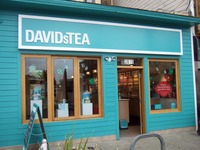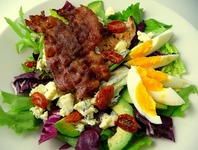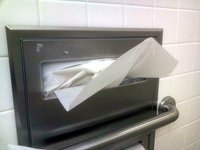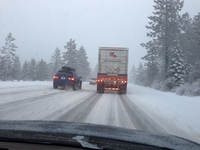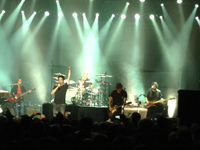 |
| Angelika/Mike Schilli |
Michael A good quality steak develops a great intensive flavor if cooked on an open-fire grill. But if you leave it on until it turns dark, German guests will proclaim that the blackened surface causes cancer, send it back to the kitchen, or grudgingly cut around the burnt parts. Interestingly, Americans don't share the same health concerns, and flat-out love their barbecue meat flame-grilled to a point where Germans would consider it burnt.
Take Dave, my colleague at work, for example. He often prepares a lunch sandwich at the cafeteria and leaves the bread in the toaster until it's almost black (Figure 1). When I jokingly comment that he could just as well smoke a cigarette, he vehemently dismisses my claim and when I ask why he's burning his toast, he laughs and says "Because I like it that way!". To understand the irony of this, you need to know that Dave neither smokes nor drinks, because it's unhealthy.
Most Americans develop a fondness for burnt food as early as pre-school. Boy and girl scout groups like to roast fluffy marshmallows over bonfires when they are out camping, until the surface of those sugary sweets turns completely black. Along with a wafer of chocoloate, they're squished between two bisquit halves, and kids just love to eat them. The dish is called a S'more, which allegedly is derived from "Some more" (Figure 2).
Hardly anyone in Germany would be drooling over the partially burnt grilled items in the supermarket flyer in Figure 3. But the question remains, is eating charred food really as harmful as it is believed in Germany? Enjoying burnt items once in a while probably won't do any harm, just as we occasionally eat fried bacon and eggs like when on vacation, although our medically inclined friends would probably be rolling their eyes over this.
Angelika We keep discovering new television shows via Netflix streaming (Rundbrief 12/2010), most of which we'd probably never had found out about otherwise. Here's a selection of the craziest shows:
Firstly, there's the reality show "Storage Wars". I've reported previously that it is common for U.S. households to rent additional small storage spaces for unneeded junk (Rundbrief 11/2009). Now, California law says, that the content of these storage lockers can be auctioned off by the storage facility if the owner is more than three months behind on the rent payments. That's exactly what this show is about.
Potential buyers at the auction face a peculiar restriction: They are only allowed to peek into the locker that's about to be auctioned off from the outside, i.e. they can't open any moving boxes or dig further into the layers of items in the locker. When they're placing a bid at the auction, all they can rely on is their experience with the content of previously purchased lockers. Of course, most lockers only contain utterly worthless junk that should rather be disposed of immediately at at the local garbage dump. But often times, between items that no sane person would keep around, there may be a folder with valuable old baseball cards or a framed painting from a famed artist which is heavily sought after by art collectors. I've always loved stories about what people keep or throw away, and about finding treasured items in hidden attics. Not surprisingly, "Storage Wars" strikes a cord for me.
The auctions in the show are held mainly in southern California. Dan and Laura Dotson are the auctioneers who strive to find buyers for the contents of abandoned lockers. The rest of the lineup are professional buyers. For example, Dave Hester is a seasoned pro, who recently started running his own auction firm. He is often employing devious tactics to outbid other buyers, sometimes just to mess with them. Darell Sheets is another buyer whose day job it is to acquire merchandize in auctions and sell them for a profit. Then, there's a married couple, Jarrod Schulz und Brandi Passante, who own a thrift store. They typically only bid on typical household items and furniture and their budget is quite limited. Another buyer, Barry Weiss, bids for the fun of it and only has an eye on collector's items and antiques.
Another TV show, "Property Wars" goes even beyond offering other people's storage items. It auctions off entire foreclosed properties. The show is recorded in Arizona, the state that was hit hard economically a couple of years ago when the housing bubble forced many home owners into forclosure. The rules of the game are similar in that potential buyers aren't allowed to inspect forclosed homes from the inside. The winning bidder gets the property and hopes that they can flip it at a higher price later.
Another funny, although borderline crazy show is "Extreme Couponing", which portraits notorious tightwads in their quest to cut their grocery bill to almost zero, by maximizing their savings while exploiting store rebates. Michael has previously written about the ubiquitous store coupons in the U.S. (Rundbrief 03/2002). There's several coupon variants, some cut the price of an item by, say, 50 cents, others reduce the price of a second item by half or give it away for free, after the customer has bought the first one at full price. Where do savings enthusiasts get their coupons? Even with the Internet as market driver, coupons today are mostly distributed with the print edition of the Sunday paper. Grocery chains like Safeway are sending them out individually by mail as well.
On Mondays, for example, we always find a booklet with coupons (Figure 6) issued by various stores in our mailbox. Various sites online offer coupon leaflets for printing at home, and recently, coupon smartphone apps have been popping up. Now, an "Extreme Couponer" is a person whose life revolves around filling binders with coupons and, when the time is right, marches down to the supermarket to unleash them all at the same time. Many of them are picking stores strategically, as some double the coupon value.
These maneuvers can lead to dramatic savings if buyers purchase exorbitant amounts of the same product. The people featured on the show often end up with entire shelves full of toilet paper, deodorant, potato chips, peanut butter, or mustard. Many fall into the "hoarder" category and often have trouble finding space for new purchases. Realistically, it's questionable if someone really can ever use up fifty packs of deodorant, so it's probably not a good deal even if they can get it dirt cheap.
You might wonder why stores participate in this game. That's easy: They get reimbursed for the coupon amounts by the manufacturer of the sold product. Those companies have a vested interest in pushing their products to the consumer, one step ahead of the competition, and that's why they sweeten the deal by issuing coupons. Arguably, extreme couponers are hardly a lucrative target for the industry, but if you think about the monetary value of product placement during the show, they can easily make up for the lost price margin.
Michael We've been living in San Francisco for 16 years already and know our way around the city pretty well. Every once in a while, we get German visitors who then want to know what to do in the city. We're usually rolling our eyes when they insist on going to the touristy "Fisherman's Wharf" area, but we've given up on lecturing our friends that this is a waste of time. For some reason, "Fisherman's Wharf" is still listed in the mainstream travel guides, and apparently, if you told your friends back home that you were on vacation in San Francisco but didn't go to the tourist area and ate clam chowder soup out of a hollow loaf of sourdough bread, they'd probably think that something is wrong with you. Oh well.
During years and years of exploring the city, however, we've kept adding to our collection of lesser known visitor attractions, which even the locals here in town find worthwhile going to occasionally. Today, I'm going to open the secret vault and let it all out!
Take a ride on the Cable Car. There's a ticket booth for tourists at Powell (next to the Bank of America ATM machines) selling daily and weekly passes for all public transportation in San Francisco (MUNI, BART, and Cable Car combined), buy one, it's a great deal. (Update 2014-06-08: The 1/3/7-Day Visitor Pass tickets seem to be available now at the ticket vending machines, no longer at the kiosk). Be there early, as around nine the line at the Cable Car gets longer and longer, at times the wait is an hour or more. Exit at Fisherman's Wharf. The Wharf area isn't really that rewarding, but tourists can't be talked out of going there, so just get it over with.
Take a ride to Crissy Fields. (or if you like hiking, it's about three miles from the Wharf). Stroll about one and a half miles alongside the Bay to Golden Gate Bridge. Get on the bridge, walk on the footpath to the first pillar (or all the way to the other end if you like). Alternatively, to get to Crissy Fields, rent a bicycle at "Blazing Saddles" at the Wharf and ride over there.
Walk barefoot in the sand at Ocean Beach. Either start just south of the Cliff House or further south at the end-of-the-line stop Ocean Beach of the N-Judah MUNI street car. Walk south as far as your feet will carry you. Alternatively, park at Sloat Street (about 2 miles south) and walk north. Collect clam shells and sand dollars.
Explore the Mission (mexican neighborhood). If you're hungry, enter a taqueria and order a burrito or tacos. The number of people standing in line are usually a reliable indicator of how good the place is. My personal recommendations: "La Taqueria" (2889 Mission Street), "Papalote" (3409 24th Street). Recommended walking path through the Mission: On 24th street, go from Potrero Street to Valencia Street. At Balmy Street (a tiny alley between Harrison Street and Treat Ave), take a short detour and check out the murals (South American style wall paintings). On Valencia Street, explore the hip/crazy stores between 24th Street and 16th Street. If you're not easily scared, proceed till Market Street and notice some run-down blocks around 14th Street. Alternatively, stop at 16th Street and visit one of the restaurant and bars. Or, enter the Zeitgeist bar and beer garden on Valencia Street at 14th Street.
Take the Alcatraz tour. But book your ticket weeks (!) in advance!
Skate through Golden Gate Park on rented roller blades.
Visit the hippie neighborhood Ashbury-Haight. Check out the stores with vintage and new hippie clothes between Ashbury Street and Golden Gate Park entrance. There's even vinyl record stores! Juvenile runaways from all parts of the country seem to gather here, loitering on the sidewalks.
Get a rental car, drive to Napa or Sonoma Valley up north. That'll take about 1.5 hours one way. Many vineyards offer wine tasting, it's no longer free, usually they charge between $5 to $20. Very good (but expensive) restaurants. If you like great traditional American food, I'd recommend Rutherford Grill.
Angelika In our Noe Valley neigborhood, there's a lot of churn these days in terms of stores, since the rents are astronomically high. Many small stores can't make enough revenue to compete. Every time when a place goes out of business, we dread what might replace it. Lately, bank branches and real estate brokers seem to occupy 24th Street in droves. In light of this, I was very pleasantly surprised when the former gift store "Ladybug Ladybug" turned into the tea store "David's Tea". My Northern-German soul rejoiced!
David's Tea originated from up north as well, Canada, to be precise. Back in 2008, David Segal opened the first store of this chain in Toronto. They've grown to about 90 stores all over Canada and the U.S., which seems to be the way to go around here if a business is doing well. David's Tea has excellent teas, starting with the usual black, green, white, and fruity teas, but also offering Roibush and various blends with coconut or vanilla. You'll find more than 150 kinds of tea there, and also nice accessories like mugs and tea pots. For Christmas, I even found tree ornaments filled with tea!
Michael Today, I'm going to introduce an item you'll probably find on American menus: the so-called Cobb Salad. It's a simple, but quite tasty dish, in a way, it's a pimped-out salad. Along green lettuce leaves, it features crispy fried bacon pieces, slices of chicken meat, and hard-boiled eggs.
Usually, it also comes with avocado and Roquefort blue cheese, and a marinade made of vinegar and oil, called "French Dressing" in the United States. Of course not mixed into the salad, but on the side in an extra cup, because Americans prefer to mix in the marinade by hand, instead of having kitchen staff take care of it.
The legend goes that restaurant owner Robert Howard Cobb invented this special salad in the 30ies of the past century, and allegedly he or his kitchen chef simply whipped up a salad made with leftovers after a hectic evening at the restaurant.
Michael Recently, our bank in Germany notified us that they no longer want our money. A new tax law called FATCA, the so-called "Foreign Account Tax Compliance Act", extends the reach of the U.S. tax bureaucracy deeply into Europe, where it, via treaties ratified by European governments, forces banks to report data on accounts owned by U.S. residents back to U.S. tax authorities. Banks in Germany, for example, are obligated to report to the U.S. Internal Revenue Service (IRS) on a regular basis, which U.S. residents have how much money stashed away in foreign accounts, to make sure those investors don't forget to pay their taxes in their country of residence.
If you know about the typical American obsession with bureaucratic process (which, ironically, most Europeans have no clue of), you can imagine that this new ordinance is peppered with idiotic clauses and requires filling out inane forms, which means European banks would have to purchase expensive software to cope with it. Instead, most smaller banks simply decided to cancel all accounts held by U.S. residents.
The acronym "FATCA" is most likely supposed to allude to "Fat Cat" tax evaders, which it was designed to discourage. It wants to track down U.S. investors who put their money into foreign accounts and don't declare the gains on their U.S. tax report. Unfortunately, the new requirements backfired also for U.S. citizens working in Europe and in need of a bank account: Only very few banks are accepting their applications.
The requirement has been ratified a while ago and went into full effect in 2013. France, Germany, Italy, Spain and the UK have agreed to comply and are sending account data to their American big brother. China has declined.
Michael Americans are generally more afraid of germs than the average German. You can easily see that here in the U.S., because no one would show up for an event with a cold. Spreading germs is considered to be extremely impolite. Or check out the dispensers with the desinfectant "Purell" in the bathrooms of companies and museums: They clearly spell out "Germophobe" to visiting Germans, who'd rather stay clear of the heavy artillery of products like Lysol or Chlorox.
Another manifestation of this phobia is the disposable toilet seat cover, to be found in almost every public toilet. These are razor-thin paper products in toilet cover shape which are to be draped onto the toilet seat before sitting down.
Extracting disposable covers from of the wall dispenser requires some practice, usually people do this by pulling the front-most cover slightly upwards first to loosen it, followed by a forceful down movement to get it out. Not following these instructions will result in torn covers, rendering them unusable. This requires some practice, but after a few tries, you'll get the hang of it.
Then the folded cover needs to be carefully unfolded and draped over the toilet seat, followed by quickly sitting down in less than three seconds, or the automatic flush will trigger and tear the cover down the drain. You can always try again.
For reasons of packaging efficiency, however, the paper covers aren't shaped like toilet seats when they're extracted from the dispenser. Instead, they're rectangle-shaped with rounded edges, and feature a partially punched-out inner oval core. Removing this core at the predetermined breaking points without tearing the entire cover apart often is a race against time.
For what it's worth, I was stuck at the shabby Charles-De-Gaulle airport in Paris once for a few hours, and noticed that not only they don't have toilet seat covers there, but no toilet seats at all! France: What an absurd country, I imagine people are hovering in acrobatic poses over the public toilet bowls. But I digress.
Another noteworthy point about American toilets is that they're all so-called deep-flushers, meaning there's about five liters of water in the bowl at all times, receiving each dropped chunk with a loud plunge. German toilets, on the other hand, feature a receiving plateau or shelf with no water, which Americans find hilarious and often write home about when they're visiting Germany.
Michael For decades, I've been accumulating paper books at home. This was especially wasteful with computer books, which were taking up space on my shelves for years to come after I had read only a few relevant pages in them and them put them aside. But thanks to the eBook revolution, which Germany is only beginning to see now with a few years of delay compared to the U.S., I came up with the idea to chop up my entire library, digitize the books by scanning them and put them online for me to read them wherever I might roam. Regardless of whether I'm waiting at the supermarket register or relaxing in a comfy folding chair at the beach, I can always access any of my 450 books and read a few pages if I feel like it.
For a while, I've been buying new books digitally at Amazon for the Kindle reader, a format that can be consumed by all kinds of tablets and mobile phones as well. My scanned books are available as PDFs on my Google Drive, and are no longer taking up space on my shelves. One of the reasons I finally took the plunge was that airlines nowadays are charging exorbitant fees for checked-in luggage. I'm no longer willing to pay extra for carrying 4 pounds of paper books on a trip. Instead, I'm now simply carrying an iPad, and have everything I've ever owned with me at all times and can read it whenever I want.
To digitize a book, I first cut off the book's cover with a box cutter. This exposes the plain pages, which are still glued together at the binding. This blob then goes into a tool called a guillotine that I purchased on Ebay for $150. Its vise holds the naked book firmly, while its sharp blade comes down and cuts the pages loose. A Fujitsu S1500 scanner's single sheet feeder then pulls the pages in individually and creates a PDF that I push to my Google Dive cloud storage space, which I can access from anywhere via an Internet connection.
In Figure 25 you can see how a digitized paper book from my former library now shows up on my new iPhone 5. It's readable on a small display, and even easier to digest on a device with a bigger screen size, like an iPad oder a Android tablet. The remainders of the chopped up paper books all went to the recycling bin.
Recently, I was waiting for my turn at my barber. I used the idle time to think about a computer problem at work, had to look up an algorithm and quickly took out my mobile phone to download a chunk of a digitized paper book in my collection. Unbelievable, what times we live in!
Michael Over the Christmas holidays, we drove to the ski area Lake Tahoe in terrible weather conditions. Leaving San Francisco in the pouring rain in the morning was only topped by getting into a snow storm on the mountain pass to Truckee at 6000 feet elevation. To prevent vehicles from getting stuck and blocking traffic, the highway patrol stopped every single car and verified if it featured a four wheel drive with snow tires. Lacking that, snow chains were required.
Thanks to modern cable chains, getting them mounted onto the tires is no longer a major task, but it still requires kneeling in front of each tire for five minutes in pouring rain of blowing snowy winds to get the different fasteners locked. If it's cold and your fingers are stiff, this can be pretty unpleasant.
But in a service-oriented society like the U.S., there's a solution: At the side of the mountain road, there's many men in yellow suits waiting to put your snow chains on for a fee of $30. You simply hand them the bag with the snow chains and then stay seated in your warm car while the snow chain man mounts the chains on your tires in the most ghastly weather. You leave the window open just a crack to follow their instructions like "turn the wheels all the way to the right" or "move back a bit" and minutes later the chains are on. 30 Dollars isn't exactly a bargain price, but if rain is pouring down outside, it's definitely worth it. The cable chains were mounted accurately, and didn't come off even with my sportive driving style.
At one point on the mountain pass, the weather worsened and snow came down really heavily and we got stuck while maneuvering between various trucks that were stranded jackknifed in the middle of the road. Before that day, I didn't even know that there is a word for the situation where the engine and driver section of a truck are pointing in one direction, and the trailer is standing off at an angle. It's called a "jackknifed truck", because it looks like a pocket knife. Shortly after our wheels started spinning without getting any more traction, a police SUV approached and the friendly officer asked if he could give us a push, which we greatly appreciated and then stayed closely behind a snow plug that had just passed. It took us 5 1/2 hours to get to Tahoe that day, not too bad, but next time, I'm going to invest in bad-ass snow chains.
AngelikaFor several years in a row, there hadn't been a Christmas party at Yahoo. But Marissa Mayer, the new CEO of Yahoo, didn't mess around and decided that there's going to be a celebration in 2012. Now, organizing a party for that many employees is certainly no easy task. Usually, a whole army of people is involved in preparing for such an event, because you have to find a suitable venue for thousands of employees and their guests.
We were lucky this year, because the party took place in San Francisco, namely at Pier 48. There was great food, a casino with roulette wheels and blackjack dealers, where guests could play for raffle tickets. As a musical highlight, they signed the band "Train", who are originally from San Francisco. Michael was bouncing up and down, because "Train" are actually a national act that he's been listening to for quite some time on his permanent rotation.
Greatings from the land of unlimited opportunities:
Angelika & Michael















